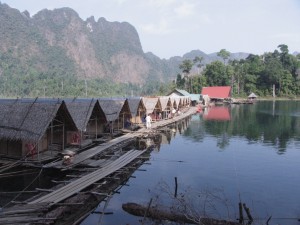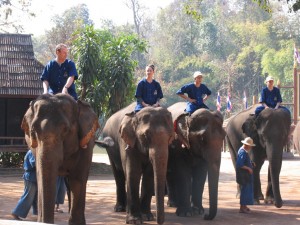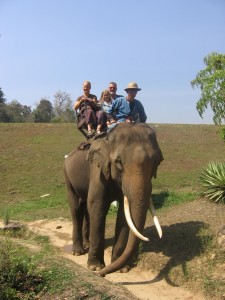Recently I posted an account of our experiences on New Zealand's north island from our January tour. After Auckland, Waitomo Cave, Otorohanga, a homestay, and the thermal wonders and Maori culture of Rotorua we were ready for the natural splendors of the south island.
Our 5th day in NZ began with a morning flight to Queenstown and the south island. The weather was mostly cloudy but we got tantalizing glimpses of alpine lakes and the Southern Alps (used as the Misty Mountains in the Lord of the Rings movies).  Queenstown (QT) has a western, sporty, welcoming vibe and a great energy. Activity centers in a pedestrian core and along the waterfront. The three pedestrian streets are interconnected by numerous
Queenstown (QT) has a western, sporty, welcoming vibe and a great energy. Activity centers in a pedestrian core and along the waterfront. The three pedestrian streets are interconnected by numerous  passageways, all lined with eateries and boutique shops, making for fun explorations. Restaurants and bars compete with adventure sports outlets and souvenir shops for tourist interest and dollars. Many restaurants have outdoor seating and its all very inviting. After free time for lunch and preliminary QT explorations, we gathered for a mountain cable car excursion up Bob’s Peak. Bob’s Peak is the quintessential QT experience.
passageways, all lined with eateries and boutique shops, making for fun explorations. Restaurants and bars compete with adventure sports outlets and souvenir shops for tourist interest and dollars. Many restaurants have outdoor seating and its all very inviting. After free time for lunch and preliminary QT explorations, we gathered for a mountain cable car excursion up Bob’s Peak. Bob’s Peak is the quintessential QT experience.  One is treated to panoramic views of the surrounding mountains, the lake, and QT down below. You can have dinner, see a Maori cultural show, have a drink in the panorama bar, or even bungee or luge. The weather was blustery, rainy, and cold as we headed up. But the wind died down and the views were spectacular, with Lake
One is treated to panoramic views of the surrounding mountains, the lake, and QT down below. You can have dinner, see a Maori cultural show, have a drink in the panorama bar, or even bungee or luge. The weather was blustery, rainy, and cold as we headed up. But the wind died down and the views were spectacular, with Lake  Wakatipu below and the Remarkables, QT’s signature mountains, marching south to the horizon. The Remarkables are certainly remarkable to see, but they are so named because they align exactly north-south, a rarity in nature.
Wakatipu below and the Remarkables, QT’s signature mountains, marching south to the horizon. The Remarkables are certainly remarkable to see, but they are so named because they align exactly north-south, a rarity in nature.  We got to see people bungee jumping, bungee swinging, and riding the luge. Several from our group tried the luge, but no one opted for the bungee. Most took a few snapshots of the surrounding splendor and then retreated to the bar for a Kiwi beer complimented by stunning views. Eventually we retreated back
We got to see people bungee jumping, bungee swinging, and riding the luge. Several from our group tried the luge, but no one opted for the bungee. Most took a few snapshots of the surrounding splendor and then retreated to the bar for a Kiwi beer complimented by stunning views. Eventually we retreated back  to QT for a pizza dinner at Winnies, another QT institution with welcoming staff, high energy atmosphere, and frontier décor complete with fireplaces and wagonwheel chandeliers.
to QT for a pizza dinner at Winnies, another QT institution with welcoming staff, high energy atmosphere, and frontier décor complete with fireplaces and wagonwheel chandeliers.
Day 6 was a highlight for everyone: our Milford Sound excursion day! We started very early on our 4 hour journey to the sound.  After a mid-morning break in Te Anau, the drive got steadily more dramatic as we headed into the Southern Alps. We were playing cat and mouse with clouds and blue sky, never sure how the weather would be at our destination. But she steadily cleared as the morning wore on. We made a first photo stop at Mirror Lakes. Aptly named, these tiny, still lakes provided mirror images of the snow-clad peaks beyond. The views escalated into the spectacular category as we approached
After a mid-morning break in Te Anau, the drive got steadily more dramatic as we headed into the Southern Alps. We were playing cat and mouse with clouds and blue sky, never sure how the weather would be at our destination. But she steadily cleared as the morning wore on. We made a first photo stop at Mirror Lakes. Aptly named, these tiny, still lakes provided mirror images of the snow-clad peaks beyond. The views escalated into the spectacular category as we approached the Homer Tunnel. The mountains form wonderful natural amphitheaters on both ends of the tunnel and multiple waterfalls spill down the cliff-like walls. The tunnel cuts through the Wick Mountains, the last barrier before the descent to Milford. Emerging from the western end, the weather was definitely clearing. The spirits of the group, already high, ratcheted up a notch in anticipation. We made one final stop at Chasm Walk, for a 15 minute trail through dense alpine forest, strewn with New Zealand’s signature ferns and mosses that put one in mind of the Olympic peninsula here in Washington. The reward waiting at the end of the trail was a spectacular series of cataracts and the twisting erosion channel they’d carved over millennia.
the Homer Tunnel. The mountains form wonderful natural amphitheaters on both ends of the tunnel and multiple waterfalls spill down the cliff-like walls. The tunnel cuts through the Wick Mountains, the last barrier before the descent to Milford. Emerging from the western end, the weather was definitely clearing. The spirits of the group, already high, ratcheted up a notch in anticipation. We made one final stop at Chasm Walk, for a 15 minute trail through dense alpine forest, strewn with New Zealand’s signature ferns and mosses that put one in mind of the Olympic peninsula here in Washington. The reward waiting at the end of the trail was a spectacular series of cataracts and the twisting erosion channel they’d carved over millennia.  Ten minutes later we were at the landing, preparing to board our Milford excursion boat. By the time our boat departed, only a handful of fluffy white clouds dotted the deep blue sky – just enough to make our pictures better. We spent the next two hours cruising the truly magnificent sound with slack jaws and tired shutter fingers. We had the best of all worlds: a clear day following several rainy days, meaning multiple waterfalls gushed down the steep sides of the fjord-like sound. Moreover, a late spring snow meant all our photographs would boast snow-capped peaks. A small group of seals sunning on some rocks just added to the magical setting. It was truly a magnificent day!
Ten minutes later we were at the landing, preparing to board our Milford excursion boat. By the time our boat departed, only a handful of fluffy white clouds dotted the deep blue sky – just enough to make our pictures better. We spent the next two hours cruising the truly magnificent sound with slack jaws and tired shutter fingers. We had the best of all worlds: a clear day following several rainy days, meaning multiple waterfalls gushed down the steep sides of the fjord-like sound. Moreover, a late spring snow meant all our photographs would boast snow-capped peaks. A small group of seals sunning on some rocks just added to the magical setting. It was truly a magnificent day!

 The long drive home was equally enjoyable as we had clear skies and new angles on the dramatic scenery and westering golden light on the Remarkables as we neared our home destination.
The long drive home was equally enjoyable as we had clear skies and new angles on the dramatic scenery and westering golden light on the Remarkables as we neared our home destination.

Our third day in Queenstown was a free day and our group engaged in a variety of the adventures and excursions on offer in the area. One couple took a Lord of the Rings tour to all the filming locations in the area. Someone else went bungy jumping at AJ Hacketts, the inventor of the “sport”.  Eleven of us started out our day by going on the original Jetboat ride up Shotover Canyon. We were able to procure a group discount and we were picked up at our hotel. The experience itself was spectacular as we screamed, laughed, hooted, and giggled our way through 360 degree bow spins and rollercoaster-like bumps, rolls, and near misses in the steep
Eleven of us started out our day by going on the original Jetboat ride up Shotover Canyon. We were able to procure a group discount and we were picked up at our hotel. The experience itself was spectacular as we screamed, laughed, hooted, and giggled our way through 360 degree bow spins and rollercoaster-like bumps, rolls, and near misses in the steep  and narrow canyon. We had to laugh at ourselves when we still screamed as our driver executed a last-second swerve to barely miss a rock or wall – even though he’d done so safely ten times before. It was a magnificent thrill ride.
and narrow canyon. We had to laugh at ourselves when we still screamed as our driver executed a last-second swerve to barely miss a rock or wall – even though he’d done so safely ten times before. It was a magnificent thrill ride.
After some lunch, Maia and I did some shopping and then visited the Kiwi & Birdlife Park. We did get to see the rare, nocturnal Kiwis at feeding time. There was even a fluffy baby – so cute!  Additionally, we saw many other birds, lizards, Maori exhibitions, and a fun conservation show. We finished off our day with a lazy lake cruise on the SS Ernsclaw, a century old steamer that still plies Lake. The weather was still crystal clear and we soaked up the evening light, the mountain scenery, and simply being on the water. It was just lovely.
Additionally, we saw many other birds, lizards, Maori exhibitions, and a fun conservation show. We finished off our day with a lazy lake cruise on the SS Ernsclaw, a century old steamer that still plies Lake. The weather was still crystal clear and we soaked up the evening light, the mountain scenery, and simply being on the water. It was just lovely.
 We departed Queenstown and drove east through the mountains. Like virtually everywhere in NZ, the scenery was great. We arrived at Shaky Bridge winery in Alexandre about 11:00AM.
We departed Queenstown and drove east through the mountains. Like virtually everywhere in NZ, the scenery was great. We arrived at Shaky Bridge winery in Alexandre about 11:00AM.  Our host Ashley introduced us to their operation and we tasted about 6 wines – all of them were delicious. Then we had a tour of the vineyard with the winemaker, a visit to the production facility, and more tasting directly from casks.
Our host Ashley introduced us to their operation and we tasted about 6 wines – all of them were delicious. Then we had a tour of the vineyard with the winemaker, a visit to the production facility, and more tasting directly from casks.  Finally we were treated to a wonderful Kiwi barbeque – fresh salmon, chicken and lamb sausages, coleslaw and salads, all with, you guessed it, great wine. I’ve done wine tastings all over Europe and this one stacked up with the best – both experience and wine quality. Another perfect weather day completed the idyllic setting. We continued on to Pukarangi where we caught the scenic Taieri Gorge Railway.
Finally we were treated to a wonderful Kiwi barbeque – fresh salmon, chicken and lamb sausages, coleslaw and salads, all with, you guessed it, great wine. I’ve done wine tastings all over Europe and this one stacked up with the best – both experience and wine quality. Another perfect weather day completed the idyllic setting. We continued on to Pukarangi where we caught the scenic Taieri Gorge Railway. The 90-year old, vintage railway cut through a pretty gorge to our destination of Dunedin. Dunedin was founded by Scots in the 19th century and one feels like you’ve arrived in a smaller version of Edinburgh (in fact, Dunedin is Gaelic for Edinburgh). There’s even a statue of Robert Burns.
The 90-year old, vintage railway cut through a pretty gorge to our destination of Dunedin. Dunedin was founded by Scots in the 19th century and one feels like you’ve arrived in a smaller version of Edinburgh (in fact, Dunedin is Gaelic for Edinburgh). There’s even a statue of Robert Burns.  Interesting architecture, a laid-back atmosphere, and a signature octagonal square in the heart of town made it a group favorite. We had a great Italian dinner together at Etrusco restaurant, just off the Octagon.
Interesting architecture, a laid-back atmosphere, and a signature octagonal square in the heart of town made it a group favorite. We had a great Italian dinner together at Etrusco restaurant, just off the Octagon.
The next day's focus was an afternoon of wildlife viewing on the Otago Peninsula. But beforehand, during a free morning, Maia and I toured the Cadbury Chocolate factory which produces all of New Zealand’s Cadbury treats.  We donned hairnets (and a beard net for me) and toured the facility learning all about chocolate production and sampling many of the products. There was even a two-story molten chocolate fall. Others visited the highly regarded Otago Museum, did some souvenir shopping, or hiked to rugged and picturesque Tunnel Beach.
We donned hairnets (and a beard net for me) and toured the facility learning all about chocolate production and sampling many of the products. There was even a two-story molten chocolate fall. Others visited the highly regarded Otago Museum, did some souvenir shopping, or hiked to rugged and picturesque Tunnel Beach.
After lunch we boarded our tour bus for the peninsula. Lovely vistas greeted us (surprise) as we wound out to the end of the land. There we visited the Royal Albatross Conservation Center.
Lovely vistas greeted us (surprise) as we wound out to the end of the land. There we visited the Royal Albatross Conservation Center.  In a brief conservation program we learned all about the giant birds (10-foot wingspan). Then we quietly crowded into the viewing blind to watch them in their natural habitat. They were quite magnificent as they wheeled and soared in the stiff winds.
In a brief conservation program we learned all about the giant birds (10-foot wingspan). Then we quietly crowded into the viewing blind to watch them in their natural habitat. They were quite magnificent as they wheeled and soared in the stiff winds. After departing, a ten-minute drive brought us to Penguin Place. A similar conservation program introduced us to the Yellow-Eyed Penguin, one of the world’s rarest, and then we
After departing, a ten-minute drive brought us to Penguin Place. A similar conservation program introduced us to the Yellow-Eyed Penguin, one of the world’s rarest, and then we  trudged down to the beach where they nest. This time a series of covered, WWI-style trenches provided the necessary penguin privacy but allowed our viewing.
trudged down to the beach where they nest. This time a series of covered, WWI-style trenches provided the necessary penguin privacy but allowed our viewing. I expected to see penguins from 20-30 feet but was pleasantly surprised to see them extremely close up. We also enjoyed seeing a small group of seals. It was a great afternoon, even with a short downpour endured at Penguin Place.
I expected to see penguins from 20-30 feet but was pleasantly surprised to see them extremely close up. We also enjoyed seeing a small group of seals. It was a great afternoon, even with a short downpour endured at Penguin Place.
Spectacular mountain scenery, beautiful Milford Sound, great wine tasting, and the wildlife of the Otago Peninsula were the highlights of the south island. The last leg of our journey would take us across the Tasman Sea to neighboring Autralia and the world class city of Sydney. I will be sharing that part of the adventure in the next couple weeks.





































































